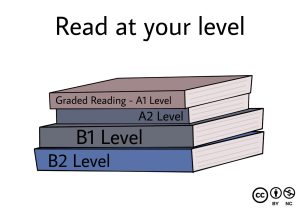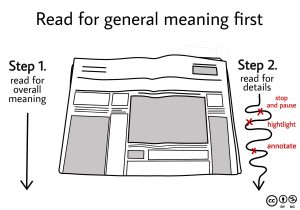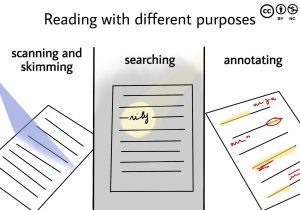Chapter 8 – Reading Skills
Reading Principles to Live By
Cameron Keaton; Bibi Halima; and Keli Yerian
This chapter is about reading, so we will be discussing both the interpretive mode (receptive skills) and the interpersonal mode (interactive reading and writing skills). As in the previous chapters on listening and speaking skills, in this chapter we provide principles that can help guide you, this time in developing your reading skills. We then discuss some of the theory and research supporting these principles, and finally show a variety of strategies and stories that have been gathered from students in LING 144 at the University of Oregon.
So what are the principles we recommend for reading in a second language?
Read for fluency at your level
Have you ever tried to read something in your L2 and felt completely overwhelmed looking up words in every sentence? Reading doesn’t have to be this way! You can read fluently as long as you’re reading at a level that’s right for you. If you are at a novice level, for example, you can read simple texts fluently, meaning you can process the meaning easily and at a fast pace without looking up many words. This kind of reading experience is called extensive reading, and it’s a great alternative to learning new vocabulary just by studying decontextualized words with flashcards.
Think of reading like training a muscle: effective reps make the muscle grow while ineffective reps can result in lack of progress and frustration. It is always good to challenge yourself, but not so much that you stop reading! You ideally should limit the amount of unknown words and grammar structures you are reading so that it stays motivating. Finding your level is as important in reading as it is in listening.
Graded readings is the term for readings that are designed to be stepping stones for different proficiency levels. For example, in most majoritized languages you can find short books written specifically for readers at different levels, such as novice, intermediate, and advanced. These books are called graded readers and are defined by Lima (2012, para. 1) from the Extensive Reading Foundation as “…books of various genres that are specially created for learners of foreign languages.” The term “graded” refers to how “the syntax and lexis are controlled in order to make the content accessible to learners of the language”.
There are options for graded readings other than graded reader books. Most textbooks include readings written for the level of the class. In addition, magazines, blog posts for learners, or even reading subtitles for simple videos in your L2 can help you read at your level of fluency. It is important to remember during your language learning journey that it takes time and you don’t have to jump into the most advanced levels of anything, at least not at the beginning!
You might ask, how can I find readings at my level?
Here are some ideas for you!

Research Note
Kara (2019) shows that students who used graded readings in an extensive reading program scored significantly higher when it came to reading comprehension than the students in the control group. The study also concluded that reading more extensively, even if the texts are less dense and shorter, improves reading comprehension more than reading less extensively, even when the text is more dense.
Keep reading, don’t stop to look up every word
When it comes to language learning, it’s okay to not understand everything all the time. We keep learning that way! When we suggest that you read “at your level” what we actually mean is to read just slightly beyond your level so that there are a few words or structures you don’t know or feel confident about yet (but not too many). As we explained in Chapter 6 about listening skills, the idea of finding your level was promoted by Stephen Krashen (1982, as cited in Western, 2020) as i + 1, where the “i” stands for the level you are at, and “+1” refers to the little bit you don’t know yet. Reading a little bit above your level is like taking on the next level in a video game. Staying always at the same level will bore you, while going ahead too fast will probably end the game.
When you are reading at a good i+1 level, you will understand enough in the reading to be able to use context clues to guess at the parts you’re not sure about and keep reading without stopping. This keeps your focus on the meaning of the reading. For example, if you read the sentence, “The tree fell down in the [unfamiliar word here] with a big crash” you could make a good guess at the meaning of the unfamiliar word by knowing that trees usually grow in the forest or woods. You don’t have to interrupt your reading to look the word up – just see if the word pops up again later and the new context will confirm or disconfirm your guess. For example, if you read in the next sentence that “A neighbor saw the tree fall down from their window”, you might make a new guess that the unfamiliar word is “yard”. Another advantage of reading at your level is that you are also practicing reading the words and structures that you already do know (like tree and crash), but each time in a different context, which helps you to deepen your understanding of how those words are used. Overall, reading without stopping keeps your focus on the big picture of the reading, which can help you make inferences along the way.
![The illustration shows a part of text from a reading "One day in the winter, [... in yellow highlight] a tree fell in the, [a word scribbled] and it caused a loud crash! emphasizing the fact that "use context clue" and don't stop to look up every word.](https://opentext.uoregon.edu/app/uploads/sites/31/2024/09/Image-1.jpeg)
Research Note
Multiple studies show that despite not understanding every single word you are reading, you can use context clues to understand what you are reading. For example, Rokni and Niknaqsh (2013) investigated the effects of context clues on Iranian EFL learners’ reading comprehension. They found that the experimental group that practiced using context clues outperformed the control group on a reading comprehension test.
Read for Gist and meaning first, then read again for Detail
When you read at your level and don’t stop to look up many words, you are reading for meaning. Reading for meaning gives you the opportunity to understand the overall meaning of the text, without getting interrupted or stuck on a few unfamiliar words or grammatical forms. The first time you read something in the language you are trying to learn, whether that be a graded book or a magazine, it is best to read for overall meaning. But then, if you take the time to read through a second or even third time, you’ll see you will understand even more. This is when it’s recommended to pay attention to the grammar clues more closely and to stop to look up words you still aren’t sure of just from the context. You can also pay attention to cultural clues that you may have missed the first time. Reading through the text multiple times allows you to understand something different on each read through. This exposure is crucial to your L2 reading comprehension development because it can help improve your word recognition skills, grow your vocabulary, and advance your reading skills (Taguchi et al., 2016).

Research Note
Studies show that reading multiple times is beneficial to your understanding of a passage. Maragolin and Snyder (2017) found that passages that were read twice were understood more deeply than passages that were read only once. Studies like this demonstrate the value of reading through a passage multiple times, and why it is okay to not focus too much on new grammar or vocabulary on your first read through.
Focus on high-frequency phrases and vocabulary first
When you are on your language learning journey everything may seem important. Every word, every phrase, every sentence. However, when you first begin it is helpful to give priority to words and phrases you will see a lot. High-frequency words and phrases are “commonly occurring words in written and spoken language. They are often referred to as sight words and used frequently in written texts such as books, articles, and other literary materials” (Voyager Sopris Learning, 2024, para. 3). Examples are the words “good” and “people”, which are in the top 100 most frequently used words in English. Luckily, graded readings and modern language textbooks focus on the most frequent words already. But if you’re reading something beyond your level and the words are unusual or specific, like “overalls” or “stutter”, you might not want to spend time memorizing them yet. High-frequency words can give you a running start on accessing more texts more quickly and growing a broader knowledge of the language.
Research Note
High-frequency words, because they appear so frequently, serve as the building blocks of language. Nishida’s (2014) study of intermediate and advanced L2 readers of English in Japan shows that readers who are more effective were “able to carry out lower-level reading processing nearly automatically” (p. 133), both in terms of recognizing vocabulary and sentence structures. This automatic processing must be developed by frequently encountering the words over time.
Read content that you care about and is useful to you
You will see a lot of progress on your language learning journey if you read on your own for pleasure. And outside of a classroom context, you can choose what content you want to read! One of the best practices is to read and use content that you truly like and find interesting. For example if you want to learn about French housing items, you could read a magazine on interior design in French, follow conversations about shopping on social media, or watch a French series about realtors. Another example could be using subtitles in your L2 while you watch your favorite show (even if you listen it in your L1). This would be a great opportunity for you to learn and pick up new vocabulary in your language as you will be watching something you enjoy and reading subtitles in the language you want to learn. So, when it comes to deciding topics or genres for you to read, pick ones that are useful to you and that you enjoy.
 Research Note
Research NoteMultiple reading studies have supported the idea that students understand readings more when they are interested in them. For example, Asgari et al. (2019) conducted research with two groups of students to measure whether readings based on students’ stated interests would have an influence on their performance in L2 reading comprehension. Asgari et al. found that the pleasure reading group made greater gains than the control group.
Use reading strategies that match Your Purpose and genre
Another way to say “genres” is “different categories of texts”. For example, novels, magazines, blogs, text messages, and textbooks are all different written genres. Depending on the genre you are reading and your purpose for reading it, it is recommended to employ different strategies to read them. For instance, when you’re reading a textbook, you might do more careful, intensive reading to be sure you understand key concepts. However, when you’re reading a newspaper, you may be more inclined to skim the text to get an overview of the day’s news. The strategies match the purpose of the genre. A textbook is written to convey complex ideas that should be read carefully, whereas a newspaper is designed to show you a lot of headlines at once.
Below are some strategies that can be implemented when reading in your L2. There will be a deeper dive into the “why” behind these strategies in the next section of this chapter.
Example reading strategies to match the genre
 Research Note
Research Note
These strategies can be useful in different contexts. For instance, scanning a text can be used if you need to find something in the text quickly without fully reading it, such as when you are looking for the name of a celebrity in social media post. Scanning allows you to search for an item within a text, which can be useful if you are reading a long text and just need to find specific elements. Grabe (2016) writes, “One of the most important factors in reading comprehension abilities is how reading processes vary depending on the reading purpose” (p. 299).
References
Asgari, M., Ketabi, S., & Amirian, Z. (2019). Interest-based language teaching: Enhancing students’ interest and achievement in L2 reading. Iranian Journal of Language Teaching Research, 7(1), 61-75.
Beglar, D., Hunt, A., & Kite, Y. (2011). The Effect of pleasure reading on Japanese university EFL learners’ reading rates. Language Learning, 62(3), 665-703.
Grabe, W. (2016). L2 reading comprehension and development. In E. Hinkel (Ed.), Handbook for second language teaching and learning (1st ed., pp. 299-311). Routledge.
Kara, B. (2019). The effects of graded readers on reading comprehension skills of EFL students. Language Teaching and Educational Research, 2(2), 160-172.
Krashen, S. D. (1982). Principles and practice in second language acquisition. Pergamon Press.
Lima, C. (2012, July 17). Graded readers. The Extensive Reading Foundation. Retrieved May 15, 2024.
Margolin, S. J., & Snyder, N. (2018). It may not be that difficult the second time around: The effects of rereading on the comprehension and metacomprehension of negated text. Journal of Research in Reading, 41(2), 392-402.
Nishida, H. (2014). Investigating differences in the reading processes of advanced and intermediate readers. Journal of Asia TEFL, 11(3), 133–156. Find in Google Scholar.
Rokni, S. J. A., & Niknaqsh, H. R. (2013). The effect of context clues on EFL learners’ reading comprehension. India International Journal, 3(6), 54-61.
Taguchi, E., Melhem, L., & Kawaguchi, T. (2016). Assisted reading: A flexible approach to L2 reading fluency building. The Reading Matrix: An International Online Journal, 16(1), 106-118.
Western, P. (2020, July 21). What is the i+1 principle? Oxford Open Learning. Retrieved May 15, 2024.
Voyager Sopris Learning. (2024, January 5). What are high-frequency words and why are they significant? Retrieved May 20, 2024.
Media Attributions
All original illustrations on this page © Addy Orsi are licensed under CC BY-NC 4.0 (Attribution NonCommercial) license.
Any language learned after the first language(s). The term "second language" does not necessarily refer to the 2nd language in time that a person learns. It can be a third, fourth, or other additional language
The way in which linguistic elements, such as words, are put together to form larger units, such as phrases or clauses
Of or relating to the vocabulary, words, or morphemes of a language
The language learning technique of listening or reading extensive amounts of text to improve general comprehension. It is done without stopping to look up words or analyze the text
Stands for comprehensible input, or a language level that is slightly above your current level
A text that has been simplified or originally written to contain a limited set of forms (in this context, 'forms' refers to vocabulary and grammar)
Language(s) you are first exposed to and learn. Note that individuals can have multiple L1s if they are raised in a bi- or multilingual community
A specific type of written or spoken text, such as novels, newspapers, blogs, speeches, conversations, etc

